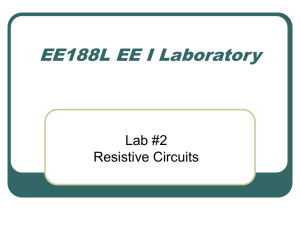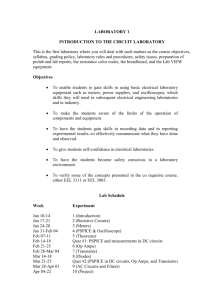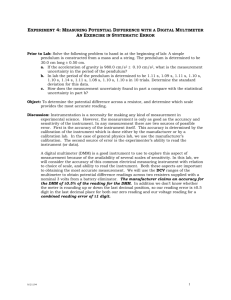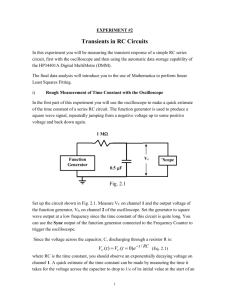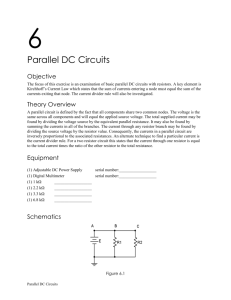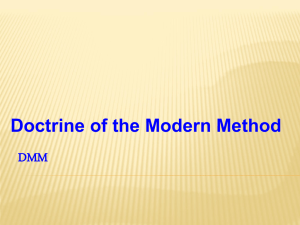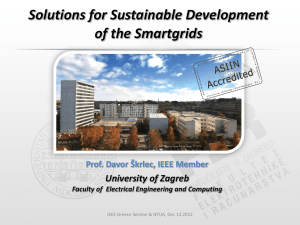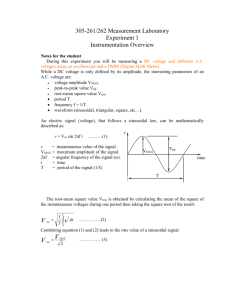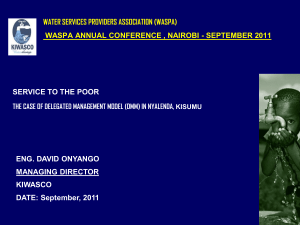sensors 3
advertisement
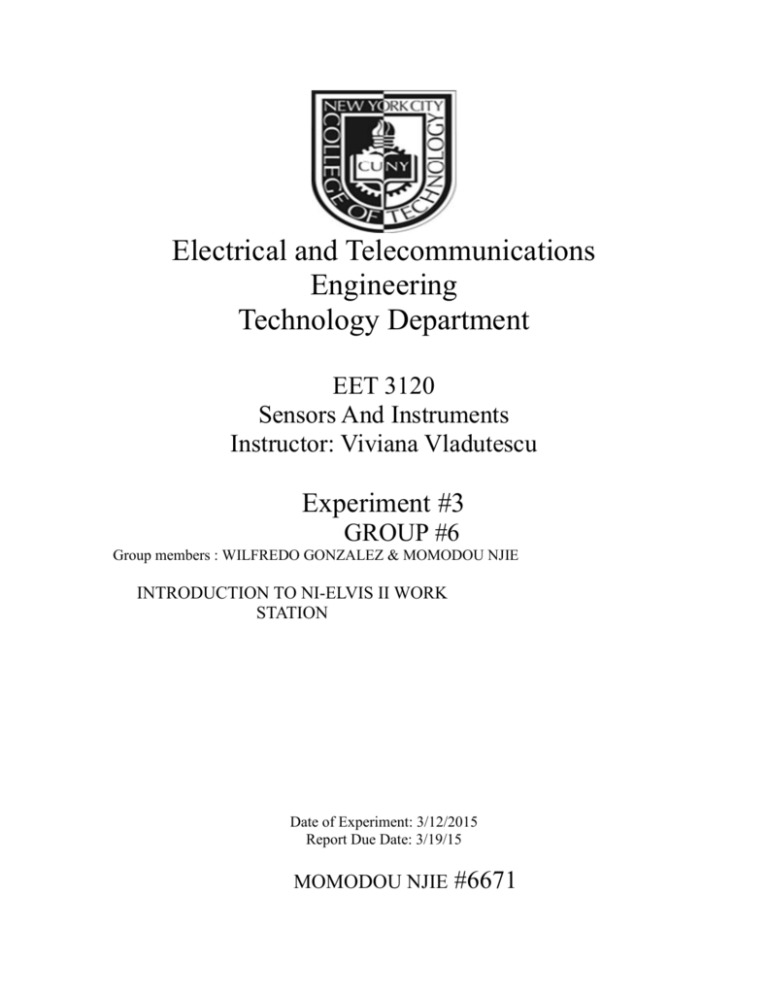
Electrical and Telecommunications
Engineering
Technology Department
EET 3120
Sensors And Instruments
Instructor: Viviana Vladutescu
Experiment #3
GROUP #6
Group members : WILFREDO GONZALEZ & MOMODOU NJIE
INTRODUCTION TO NI-ELVIS II WORK
STATION
Date of Experiment: 3/12/2015
Report Due Date: 3/19/15
MOMODOU NJIE
#6671
Table of Contents:
1. Objective
2. Brief Theory
3. Programs/Results
4. Conclusion
– Page 2
– Page 2
– Page 3-14
– Page 14
INTRODUCTIONS:
A computer based instrument is assembled inside or outside a computer and uses the
computer for data acquisition, processing measurement, display and communication. A
computer based instrument consists of the following components:
The computer
Hardware for data acquisition and instrument communication.
Computer based instrumentation software.
Objective:
This lab introduce the idea of a computer based instruments through building a
simple instrument using the NI ELVIS II workstation and controlling it with a LabVIEW
program. The lab also gives a short tutorial for LabVIEW programming
Equipment:
LabVIEW 2010, NI ELVIS II software, Digital Multimeter, Digital Voltmeter, Digital
Ammeter, Digital Ohmmeter, Digital Capacitance Meter, 1 Kilo-Ohms Resistors, 2.2
Kilo-Ohms Resistors, 1Mega- Ohms Resistors, 5.6 Kilo-Ohms Resistors, 1 Micro-farad
capacitor. We will require also several hardware components to build the circuit which
include Wires to build circuits, 2 Vernier Analog Proto Board Connectors, Vernier and
Lab VIEW NI ELVIS II software application programmatic interface Virtual Instrument.
Theory needed:
LabVIEW is a graphical programming environment that is used by engineers and
scientists in order to develop sophisticated measurement, test, and control systems using
intuitive graphical icons and wires that resemble a flowchart. This program offers strong
integration with thousands of hardware devices and provides a lot of built-in libraries for
advanced analysis and data visualizations. In addition, this program is also scalable
across multiple computer targets and operating systems, becoming an industry leader
since its introduction in 1986. LabVIEW helps their users build measurement
applications in the shortest amount of time and without requiring them to have a
computer science degree
This software also has 12 virtual instruments for hands-on learning, which includes
circuit designing, control designing, digital electronics, microcontroller systems,
telecommunications, and renewable energy.
Procedure of the Experiment :
First and famous we are going to open labview program
Two windows will pop up, block diagram and front panel, then connect the NI ELVIS II
workstation to a computer and power up NI ELVIS II
Input data using controls palette from the view menu.
On the computer screen, click on the NI -ELVISmx instrument Launcher Icon or shortcut
and a strip of NI ELVIS II appears on the screen.
Connect two Banana- type leads to the digital Multimeter input, COM on the left of the
workstation and connect the other end to one end of the resistor.
Then click on the DMM icon within the Launcher strip to select the digital multimeter
and measure the resistance of the resistors.
Results and analyses:
The 1Kilo-Ohms resistor measured 1.0098 Kilo-Ohms
The 2.2 Kilo-Ohms resistor measured 2.1505 Kilo-Ohms
The 1Mega-Ohms resistor measured 0.971 Mega-Ohms
ON the next Exercise we build a Voltage Divider circuit with a 1Kilo-Ohms resistor and
a 2.2 Kilo-Ohms resistor . After making all the necessary connections we then
measured the input Voltage {Vo} with the DMM and obtain 3.3561Vdc.
According the circuit theory V2 R2/(R1+R2)*Vo
By using the previous measurement values above we can calculate V2 by
V2 R2/(R1+R2)*Vo
V2 2.1505k/(1.0098k+2.1505k)*3.3561V
V2 2.2837V
Note that measured value which is 3.3561V is totally different or way higher than the
calculated value which is 2.2837V
On this exercise we used the DMM to measure the current:
Using Ohm’s law we calculated the current by
I V/ R
I 3.3561/2.2
I0.0015A
The measured and calculated values are more or less the same because the calculated
value is 0.0015A and the measure is 0.0009A
On the next exercise we observed the voltage develop on an RC Transient circuit by
replacing both resistors with a 1M resistor and a 1F capacitor. The capacitor is then
measured with the protoboard energized and the measured value was 1.06F
After our circuit is complete on our board, we opened LabView, and opened the RC Transient.vi
VI. This VI shows us the charging and discharging of our RC circuit, as shown in the following
waveform:
Vi. See figure shown below:
With this circuit set-up, we click "run" on the DMM SFP and observe the measured
voltage. We multiplied this voltage by 100 to obtain a temperature in Kelvins. By putting
our hand on the temperature sensor, we may see the temperature change.
Building a thermometer using the DMM express VI in LabView
By starting up LabView, then opening the temperature monitoring.vi, we made the
following modifications: We proceeded to the measurement I/O, then NI ELVISmx and
selected the NI ELVISmx DMM express VI. We placed this into the while loop from the
temperature monitoring.vi, as shown:
With this done, we proceeded to delete the voltage vi already included from the
previous VI, and connected this wire to the DMM. As seen from the picture, we also
created the scale select from right clicking on the scale select input of the temperature
subVI and creating the control. With these steps complete, we ran the VI and observed
the temperatures.
Exercise 2: Building a thermometer using the DMM using the SFP
Measured voltage across LM335 was 2.9955 volts.
So, t [K] =U [V]*100
Dmm SFP
Building a thermometer using the DMM express VI in LabView
Temperature values by using LabViewL
DMM SFP Hand Temperature
Start the DMM SFP and press the Run button. Notice the measured voltage. Multiply by
100 manually. The resulting value is temperature in the Kelvin scale. Use Equations to
obtain the temperature in the Celsius and Fahrenheit scales.
. Put your hand on the temperature sensor and notice the modification of the temperature.
Diagram of real Temperature Monitoring
. Navigate to Measurement I/O»NI ELVISmx and select the NI. ELVISmx Digital
Multimeter express VI. Place it inside of the While Loop. The SFP will open (Figure
below).
. Delete the Voltage Read subVI and the connection wire between this subVI and the
temperature subVI.
. Stop the DMM by pressing the Stop button.
. Press the OK button and wait until the compilation of the VI is done.
. Connect the Measurement output of the digital multimeter with the voltage input of the
Temperature subVI (Figure below).
Building a Thermometer Using the DMM Express
Create the Scale select control. Right click on the Scale select input of the Temperature
subVI and select the Create Control option.
. Activate the Panel window of the VI.
. Run the VI and see the measured temperature. Put your hand on the temperature sensor
and notice the variation.
. Select another temperature scale from the Scale select control and see the values.
. Press the STOP button. Save the VI as Real Temperature Monitoring.
Building a Thermometer Using the DMM Express with hand on
CONCLUSION:
In conclusion, we were able to familiarize ourselves with computer based NI ELVIS II
and LabView to control the work station. We worked through each exercise which
obtained different objectives and measurements, as well as circuit analysis. The last one
was challenging but we was able to get results.
References:
Lab manual
